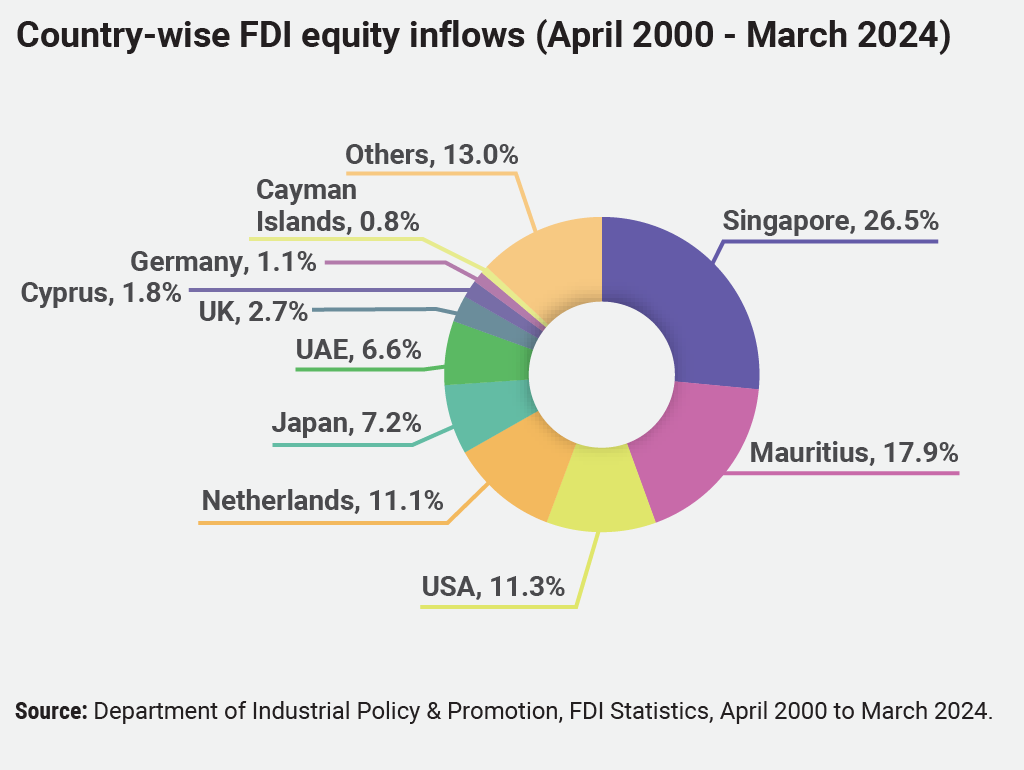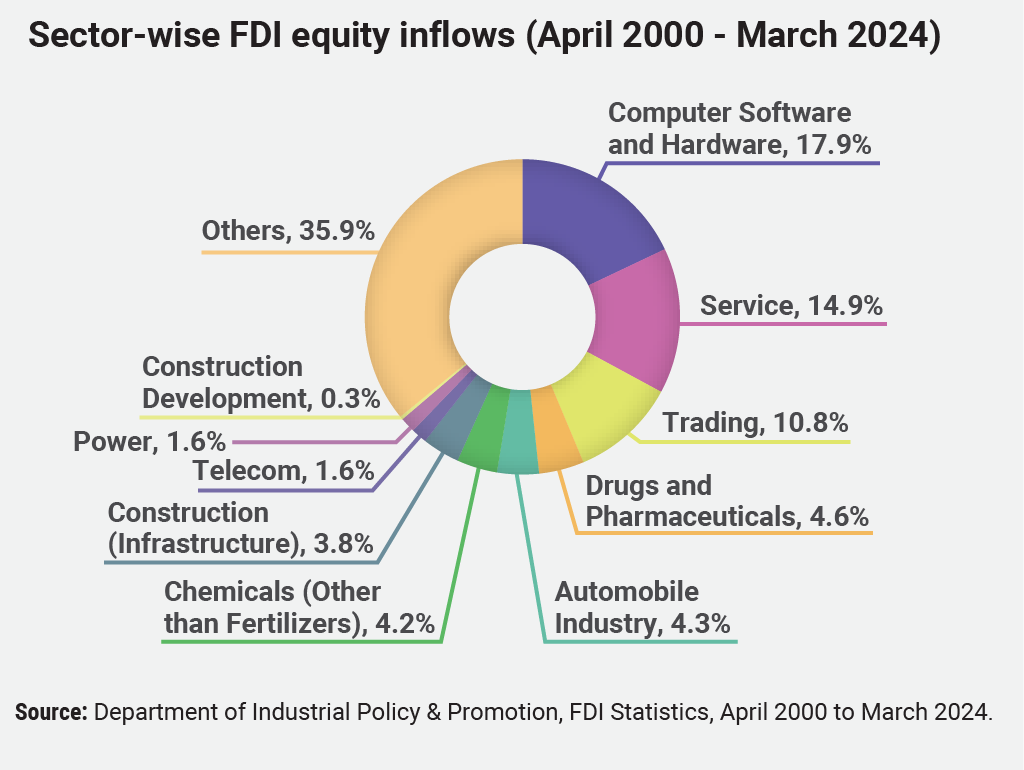Introducing India
Economy
India is the third-largest economy in terms of Gross Domestic Product (GDP) based on Purchasing Power Parity (PPP). India has been one of the fastest-growing economies over the last decade.
The service sector has been driving economic growth in India, accounting for 54.7% of Gross Value Added (GVA) growth (at current prices), followed by the industry sector with a 27.6% share, and agriculture accounting for 17.7% in FY 2023-24. However, agriculture remains the largest employer, engaging over 45% of the total workforce, followed by the service sector employing 28.9%1.
The Indian economy has solidified its post-COVID recovery, with both fiscal and monetary policies contributing to economic and financial stability. In a challenging global environment, India has emerged as a key economic and geopolitical power. The country's focus on a rules-based international order, its advocacy for collaborative solutions to common challenges, and its commitment to democratic values have established it as a stabilizing force in an increasingly complex global geopolitical landscape. Through initiatives like Mission Lifestyle for Environment (LiFE), the push for Green Hydrogen, and investments in infrastructure and connectivity—such as the Bharatmala highway program, the Sagarmala project for port-led development, and the Smart Cities Mission, India is transforming its economic landscape and playing a pivotal role in global progress.
In line with India's vision of becoming 'Atmanirbhar,' Production Linked Incentive (PLI) Schemes have been introduced for 14 key sectors with a total outlay of USD 24.63 billion. These schemes aim to significantly enhance domestic production, make Indian companies globally competitive, and drive economic growth. By March 2024, 755 applications have been approved across these sectors, attracting investments of USD 15.38 billion and generating approximately 0.8 million jobs.2.
In recent years, India has implemented a slew of reforms and initiatives aimed at improving the country’s attractiveness to foreign investors. This is clearly envisioned in the Global Innovation Index (GII) report 2024, where India ranks as the 39th innovative country amongst 132 countries in terms of political environment, education, infrastructure, and knowledge creation of economy3. This marks India as one of the top climbers of the decade in terms of ranking. Further, in Central and Southern Asia, India positions itself as rank 1. Further, as per the CB Insights’ Tracker of Unicorn companies, as of April 2023, India has the third largest unicorn base in the world.
Amidst severe global economic headwinds, and supply chain disruptions, the Indian economy has recovered and expanded steadily over the past three years. By FY 2023-24, real GDP was 20% higher than in FY 2019-20, a milestone achieved by only a few major economies, positioning India for strong growth in FY 2024-25 and beyond4. In pursuit of the Government's vision of becoming a developed nation by 2047, the Government aims to5:
- Complement the macro-economic level growth focus with a micro-economic level all-inclusive welfare focus.
- Promote digital economy & fintech, technology-enabled development, energy transition, and climate action.
- Rely on the virtuous cycle starting from private investment with public capital investment helping to crowd-in private investment.
Aligned with this forward-looking and inclusive vision, the Government has implemented various initiatives, including efforts to enhance women's development, health, education, skill development, science and technology, infrastructure, employment, agriculture, manufacturing, industrial production, innovation, and the growth of indigenous industries.
Real GDP Growth in India: FY 2012-23 to FY 2015-26

Foreign Trade6: Despite persistent global challenges, total exports (services and goods) in FY 2023-24 exceeded the previous year's record, reaching an estimated USD 776.68 billion, slightly higher than the USD 776.40 billion in FY 2022-23. Imports for FY 2023-24 are estimated at USD 854.80 billion, down by approximately 4.9% from USD 898.01 billion in FY 2022-23.
India’s service sector saw a 4.3% increase in exports, rising from USD 325.33 billion in FY 2022-23 to USD 339.62 billion in FY 2023-24. Imports in this sector decreased by 2.5%, from USD 182.05 billion in FY 2022-23 to USD 177.56 billion in FY 2023-24, resulting in a trade balance of USD 162 billion for FY 2023-24.
In the goods sector, both exports and imports declined in FY 2023-24 compared to the previous year. Exports dropped by 3.11%, from USD 451.07 billion in FY 2022-23 to USD 437.06 billion in FY 2023-24. Similarly, imports fell by 5.41%, from USD 715.97 billion in FY 2022-23 to USD 677.24 billion in FY 2023-24.
Key drivers of goods export growth in FY 2023-24 included Electronic Goods, Drugs and Pharmaceuticals, Engineering Goods, Iron Ore, Cotton Yarn/Fabrics/Made-ups, Handloom Products, along with Ceramic products and Glassware. Notably, exports of Electronic Goods and Drugs and Pharmaceuticals rose by 23.64% and 9.67%, respectively, compared to the previous year.
Foreign Direct Investment (FDI)7: India has emerged as a prime destination for Foreign Direct Investment (FDI) in recent years, driven by various factors that have significantly enhanced its appeal. The UNCTAD's World Investment Report 2023 ranks India as the eighth most preferred FDI destination globally. Moreover, India stands among the top three countries for greenfield investment announcements and ranks second in international project finance deals.
FDI Inflow8: From April 2000 to March 2024, cumulative FDI inflows into India stood at USD 990.97 billion. In FY 2023-24 alone, FDI inflows amounted to USD 70.95 billion, with Maharashtra, Gujarat, and Karnataka accounting for over 40% of the total share.
Annual FDI Equity Inflows into India: FY 2010-11 to FY 2023-24

Country-Wise FDI Equity Inflows: 2023-24
From April 2000 to March 2024, cumulative FDI equity inflows from Mauritius stood at USD 171.85 billion, making it the largest source of FDI into India. Mauritius, Singapore and USA contributed to more than 55% of cumulative India’s FDI equity inflows during both time periods (FY 2023-24 and April 2000- March 2024). During FY 2023-24, Singapore was the top investor with USD 11.77 billion, followed by Mauritius, USA, Netherlands, Japan, UAE, United Kingdom, Cyprus, Germany, and Cayman Islands. It is pertinent to note that some of the key countries mentioned here are favourable jurisdictions to make investments in India.

Sector-wise FDI Equity Inflows: 2023-2024
From April 2000 to March 2024, the Service Sector and Computer Hardware and Software sector attracted the highest FDI equity inflow accounting for 16% and 15% respectively of all inflows followed by Trading (6%). In FY 2023-24, the Computer Hardware and Software sector received the highest amount of FDI equity inflows (USD 7.97 billion) followed by the Service Sector, Trading, Drugs and Pharmaceuticals, Automobile Industry, Chemicals, Construction (Infrastructure) Activities, Telecommunications, Power, and Construction Development.

- 1. Sector-wise GVA data, Economic Survey 2023-24, https://www.indiabudget.gov.in/economicsurvey/doc/echapter.pdf
- 2. Ministry of Commerce & Industry, https://pib.gov.in/PressReleasePage.aspx?PRID=2039119
- 3. Global Innovation Index 2024, https://www.wipo.int/web-publications/global-innovation-index-2024/assets/67729/2000%20Global%20Innovation%20Index%202024_WEB3lite.pdf
- 4. PIB – Government of India, https://static.pib.gov.in/WriteReadData/specificdocs/documents/2024/jul/doc2024722351601.pdf
- 5. Vision India @2047, https://pib.gov.in/PressReleasePage.aspx?PRID=1794129
- 6. Ministry of Commerce & Industry, https://pib.gov.in/PressReleseDetailm.aspx?PRID=2017942
- 7. World Investment Report 2023, https://unctad.org/system/files/official-document/wir2023_en.pdf
- 8. Factsheet on FDI inflow, https://dpiit.gov.in/sites/default/files/FDI_Factsheet_30May2024.pdf

